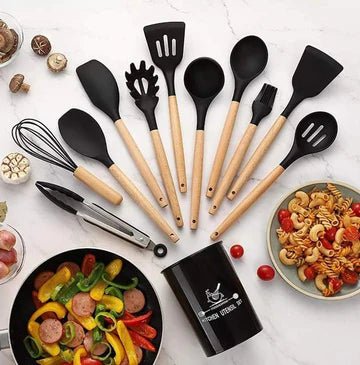


Discover the key differences between silicone and traditional cookware to choose the best option for your kitchen needs.
Cooking tools have evolved drastically in recent years, with materials like silicone joining the ranks of traditional options like stainless steel, cast iron, and non-stick coatings. As more households embrace modern cooking solutions, it’s worth exploring how silicone cookware stacks up against its more conventional counterparts. This article will dive into the key differences, benefits, and limitations of both options to help you make an informed choice.
Silicone cookware is made from food-grade silicone—a synthetic rubber that is flexible, heat-resistant, and non-reactive. It has become increasingly popular for items like baking mats, spatulas, muffin molds, and pot holders. Known for its vibrant colours and unique feel, silicone provides a modern alternative that blends style with function. Unlike metal or ceramic, it won’t scratch your pots or react with acidic foods.
Traditional cookware typically includes stainless steel pots, cast iron pans, non-stick aluminium skillets, and ceramic-coated items. These materials have stood the test of time and are trusted for their durability, heat retention, and cooking performance. Cast iron, for instance, is praised for even heating and long-lasting performance, while stainless steel resists corrosion and maintains a clean look.
When it comes to durability, traditional cookware tends to lead. A well-maintained cast iron skillet can last generations. Stainless steel and ceramic are also known for their long-term use, although they may require more attention when cleaning. Most traditional pieces are dishwasher safe but can develop stains or lose their shine over time.
Performance in the kitchen is where traditional cookware often shines. Cast iron and stainless steel excel at searing, browning, and sautéing, offering better heat distribution and control. Non-stick pans are great for low-fat cooking and easy flipping but may degrade faster with heavy use.
Health-conscious cooks may prefer silicone cookware because it is BPA-free, non-toxic, and non-reactive with acidic or alkaline ingredients. It doesn’t leach harmful chemicals into food and is considered a safer option than some older non-stick pans. However, always ensure you’re buying FDA-approved, food-grade silicone.
Traditional materials like stainless steel and cast iron are also safe, with the added bonus of being recyclable. Ceramic coatings are usually safe but can chip over time, exposing the underlying material. Non-stick coatings, especially older ones, may pose health concerns when they degrade.
Your choice between silicone cookware and traditional cookware largely depends on your cooking style and kitchen needs. If you’re an avid baker or need versatile, easy-to-clean tools for light cooking, silicone is a great addition to your kitchen. But for high-heat applications, searing meat, or serious stovetop cooking, traditional materials like cast iron or stainless steel remain superior.
Many households find a combination of both works best. Use silicone for baking, prep, and storage, and rely on traditional cookware for more intensive cooking tasks. This balanced approach offers the best of both worlds.
Silicone and traditional cookware each have their own strengths. While silicone offers convenience, safety, and modern design, traditional materials provide unmatched performance and longevity. Understanding the benefits and limitations of each will help you build a kitchen that’s efficient, safe, and enjoyable to use.
